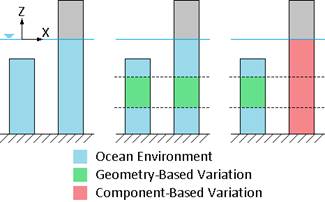You may choose to override the structural coefficients defined in the Ocean Environment object, for a selection of line bodies, using the Component-Based Variation object. You may add as many of these to the analysis as required.
Use the Scoping Method and Geometry/Named Selection options to select the component (line body) to which the structural coefficient adjustments will be applied.
For the Component-Based Variation object, Default Member Flooding has four available options:
True: the selected component is flooded with seawater.
False: the selected component is not flooded.
Program Controlled: the option inherits the Default Member Flooding defined in the Ocean Environment Structural Coefficients details.
Internal Fluid: the selected component is flooded with a fluid, of a density defined by the Fluid Density, up to the specified Free Surface Level. No other modifications to the structural coefficients of the component may be made with this object.
The Added Mass Coefficient in Y (CaY), Added Mass Coefficient in Z (CaZ) and Buoyancy Force Ratio options are described in Structural Coefficients, but apply only to the selected component.
By default the variation is applied to the whole of the selected component, and the structural coefficients (Drag Coefficient in Y (CdY), Drag Coefficient in Z (CdZ), Drag Coefficient in X (CtX), Inertia Coefficient in Y (CmY), Inertia Coefficient in Z (CmZ), Bio-Fouling Added Mass and Bio-Fouling Added Thickness) are defined in the Entire Component tabular data input.
However, the Variation Type can be changed from Entire Component to
Piecewise Variation Over Component. This allows you to define drag and inertia properties at
different vertical Z positions along the length of the component, in the Piecewise
Variation Over Component tabular data input. The Z Level is
entered in the first column, followed by the drag and inertia coefficients, and the bio-fouling
properties. All coefficients are defined in the local line body axes. Click the  icon to add more rows to the table.
icon to add more rows to the table.
The Variation Type can also be set to Program Controlled, which causes the drag and inertia properties to be inherited from those defined in the Ocean Environment Structural Coefficients or any applicable Geometry-Based Variation object. This also applies to regions of the component which lie outside of the range of vertical Z positions defined in the Piecewise Variation Over Component table when the Variation Type is set to Piecewise Variation Over Component.
In Static Structural and Transient Structural analyses, you may use the Load Step Number option to set the steps at which the Component-Based Variation object is applied. By default the object is applied for All steps; if required, change this to Range and specify the Starting Load Step and Ending Load Step to define a range of steps.
Precedence of Local Adjustments to Structural Coefficients
Where there are multiple definitions of structural coefficients applied to a range of water depths, the order of precedence is:
Component-Based Variation (most significant)
Geometry-Based Variation
Ocean Environment (least significant)




